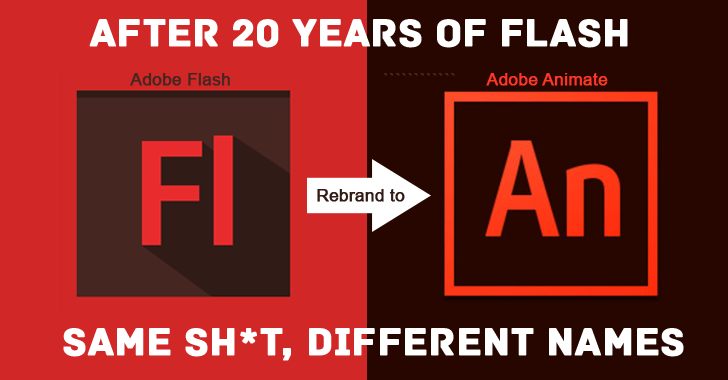- Oct 2, 2011
- 1,534


Adobe to Kill 'FLASH', but by Just Renaming it as 'Adobe Animate CC'
Tuesday, December 01, 2015 Swati Khandelwal

Adobe is Finally Killing FLASH, but not actually.
Adobe Flash made the Internet a better place with slick graphics, animation, games and applications, but it never stood a chance of surviving in the same world as HTML5.
Of course, Flash has plagued with various stability and security issues, which is why developers had hated the technology for years.
So, now it's time to say GoodBye to Adobe Flash Professional CC, and Welcome Adobe Animate CC.
Meet the new Flash, Adobe Animate CC, same as the old Flash, and still insecure mess.
Adobe Animate CC Embraces HTML5
Adobe has officially announced that "over a third of all content created in Flash Professional today uses HTML5," so the company is acknowledging the shift with the new name.
Adobe Animate CC — Adobe's Premier Web animation tool for developing HTML5 content.
Yes, that's what the company has the focus on.
The application – mostly looks like an update to the Flash Professional software – will still support Adobe Flash (SWF) and AIR formats 'as first-class citizens,' along with other animation and video formats, including HTML5 canvas, 4K and WebGL output.
Adobe Animate CC is the Same Old Flash
When Adobe Animate CC launches in January 2016, it will bring features like easy access to high-quality stock art, new vector art brushes, as well as the ability to rotate the canvas 360° from any pivot point. Sounds exciting!
What it won't bring is:
- Fix for the number of security issues that have plagued Adobe Flash for years
So, Flash isn't actually dead; it's just renamed.
"Adobe's strategy is to make money regardless of what happens in the market," says Jeffrey Hammonds, principal analyst at Forrester Research. "They understand that there is a slow transition to HTML5 going on."
"At some point you have to embrace the change," Hammond adds. "The rebranding is the visible sign of that, but the internal focus on supporting the technologies like HTML5 has been going on a while."
So, hiding Flash behind a different name doesn't solve the stability and security issues. In fact, a recently uncovered flaw in the software was so nasty that the only way to get rid of it was to completely uninstall Flash Player.
Still think Flash is dead or very much alive? Hit the comments below.